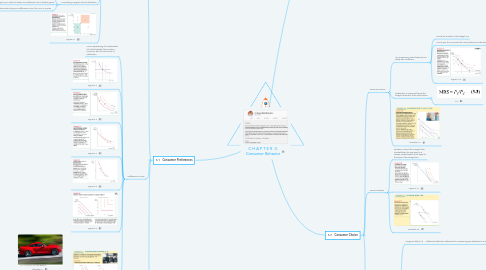
1. 3.1 Consumer Preferences
1.1. Some Basic Assumptions about Preferences
1.1.1. Completeness
1.1.1.1. consumers can compare and rank all possible baskets
1.1.1.2. for any two market baskets A and B, a consumer will prefer A to B, will prefer B to A, or will be indifferent between the two.
1.1.1.3. By indifferent we mean that a person will be equally satisfied with either basket.
1.1.1.4. these preferences ignore costs
1.1.1.4.1. A consumer might prefer steak to hamburger but buy hamburger because it is cheaper
1.1.2. Transitivity
1.1.2.1. Transitivity means that if a consumer prefers basket A to basket B and basket B to basket C, then the consumer also prefers A to C
1.1.2.2. Transitivity is normally regarded as necessary for consumer consistency
1.1.3. More is better than less
1.1.3.1. Goods are assumed to be desirable—i.e., to be good.
1.1.3.2. Consequently, consumers always prefer more of any good to less. In addition, consumers are never satisfied or satiated; more is always better, even if just a little better.
1.1.4. Diminishing marginal rate of substitution
1.1.4.1. marginal rate of substitution (MRS) Maximum amount of a good that a consumer is willing to give up in order to obtain one additional unit of another good.
1.1.4.2. marginal rate of substitution (MRS) Maximum amount of a good that a consumer is willing to give up in order to obtain one additional unit of another good.
1.1.4.3. When the MRS diminishes along an indifference curve, the curve is convex.
1.1.5. Figure 3.1
1.2. Indifference Curves
1.2.1. Curve representing all combinations of market baskets that provide a consumer with the same level of satisfaction.
1.2.2. Figure 3.2
1.2.3. Figure 3.3
1.2.4. Figure 3.4
1.2.5. Figure 3.5
1.2.6. Figure 3.6
1.2.7. Example 3.1
1.2.7.1. Illustration 1
1.2.7.2. Illustration 2
1.3. Utility & Utility Functions
1.3.1. Utility
1.3.1.1. Numerical score representing the satisfaction that a consumer gets from a given market basket.
1.3.2. Utility function
1.3.2.1. Formula that assigns a level of utility to individual market baskets.
1.3.2.2. Figure 3.8
1.3.3. Example 3.2
1.3.3.1. Illustration 1
1.3.3.2. Illustration 2
2. 3.2 Budget Constraints
2.1. Budget constraints
2.1.1. Constraints that consumers face as a result of limited incomes.
2.2. Budget line
2.2.1. All combinations of goods for which the total amount of money spent is equal to income.
2.2.2. Figure 3.10
2.2.3. Figure 3.11
2.2.4. Figure 3.12
3. 3.3 Consumer Choice
3.1. Consumer Choice
3.1.1. The maximizing market basket must satisfy two conditions:
3.1.1.1. It must be located on the budget line.
3.1.1.2. It must give the consumer the most preferred combination of goods and services.
3.1.1.3. Figure 3.13
3.1.2. Satisfaction is maximized (given the budget constraint) at the point where
3.1.2.1. 3.3
3.1.3. Example 3.4
3.2. Corner Solutions
3.2.1. Situation in which the marginal rate of substitution for one good in a chosen market basket is not equal to the slope of the budget line.
3.2.2. Figure 3.15
3.2.3. Example 3.5
3.3. Marginal Utility and Consumer Choice
3.3.1. marginal utility (MU) Additional satisfaction obtained from consuming one additional unit of a good.
3.3.1.1. 3.5
3.3.2. diminishing marginal utility Principle that as more of a good is consumed, the consumption of additional amounts will yield smaller additions to utility.
3.3.2.1. Illustration 1
3.3.2.2. Illustration 2
3.3.2.3. Illustration 3
3.3.3. equal marginal principle
3.3.3.1. Principle that utility is maximized when the consumer has equalized the marginal utility per dollar of expenditure across all goods.
3.3.3.2. 3.7
3.3.4. Example 3.7

